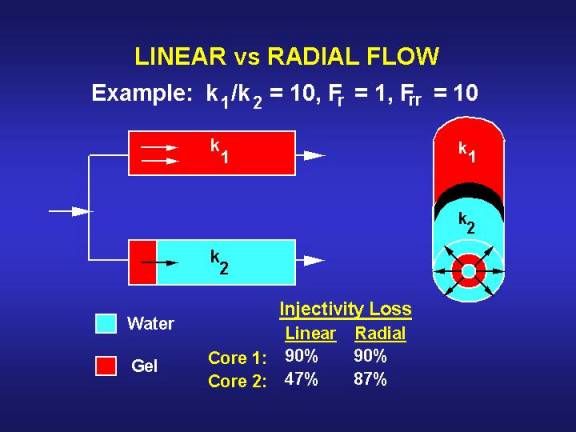Linear Versus Radial Flow
Basic calculations using the Darcy equation reveal three important facts.1 First, gelants and similar fluid blocking agents can penetrate a significant distance into all open zones. Second, an acceptable gelant placement is much easier to achieve in linear flow than in radial flow. Third, if flow is radial, then hydrocarbon-productive zones must be protected during gelant placement.
The above statements can be understood by comparing calculations for linear versus radial parallel corefloods (see Fig. 1). In each set of corefloods, assume that Core 1 is 10 times more permeable than Core 2 (i.e., k1/k2=10) and both cores have the same porosity. Initially, all cores are filled with water.

A gelant-with a water-like viscosity, i.e., the resistance factor, Fr, is equal to 1-is injected simultaneously into Cores 1 and 2 until Core 1 is filled. For the parallel linear corefloods, the gelant fills the first 10% of the pore space in Core 2. For the radial floods, the volume of gelant entering Core 2 is also 10% of the volume that enters Core 1; however, because the radius of the gelant front varies with the square root of the volume injected, the final gelant radius in Core 2 is approximately 1/3 (i.e.,≈√0.1 ) that in Core 1.
After the gelant is placed, flow is stopped to promote gelation. Wherever the gel forms, the permeability to water is reduced by a factor of 10 (i.e., the residual resistance factor, Frr, is equal to 10). Next, water injection is resumed, and the final water injectivity is determined for each core. In both the linear and radial corefloods, Core 1 is completely filled with gel, so it experiences a 90% injectivity loss. For the linear case, a 47% injectivity loss is calculated for Core 2 (using the Darcy equation for flow in series).1 Since a much larger injectivity loss occurs in the high-permeability core, the gel treatment significantly improves the injection profile. However, the damage to Core 2 is significant.
In the radial system, calculations (again, using the Darcy equation for flow in series)1 reveal that Core 2 experiences an 87% injectivity loss. Therefore, in radial flow, the gel treatment causes approximately a 90% injectivity loss in both cores without significantly improving the injection profile. These simple calculations illustrate two of the three important facts that are revealed by the Darcy equation: an acceptable gelant placement is much easier to achieve in linear flow (e.g., vertically fractured wells) than in radial flow (e.g., wells without fractures), and if flow is radial, then hydrocarbon-productive zones must be protected during gelant placement.